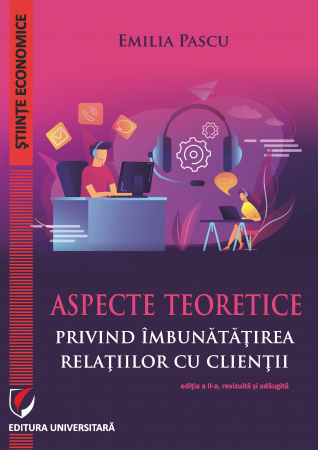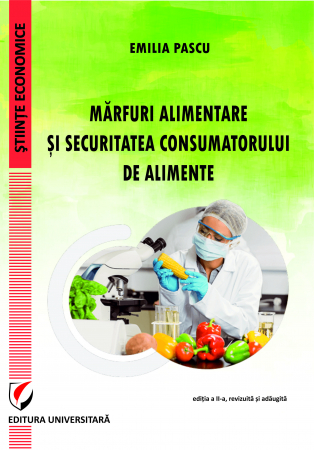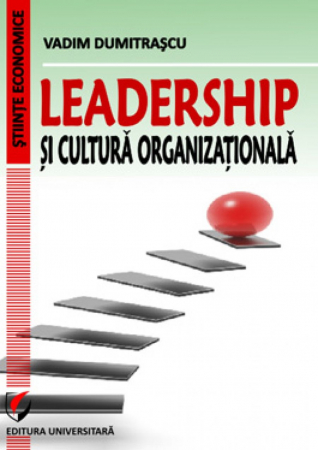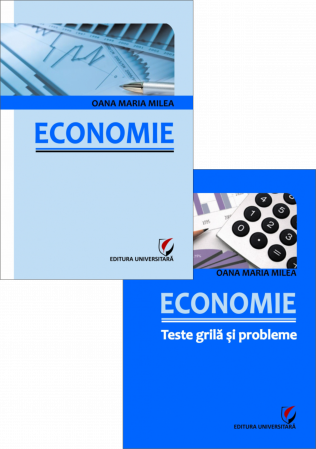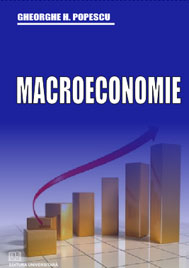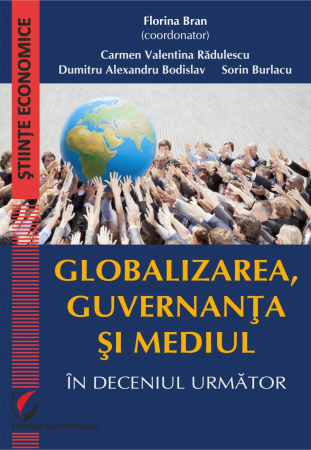Publisher: Editura Universitara
Author: Victor Munteanu - Coordonator, Marilena Zuca, Rodica Munteanu, Simina Vera, Camelia Nedea
ISBN: 978-606-28-0397-1
DOI: 10.5682/9786062803971
Publisher year: 2016
Edition: III, revizuita si adaugita
Pages: 506
- Description
- Download (1)
- Authors
- Content
- More details
- Where to find it
- Reviews (0)
It is intended, secondly, for trainees and practitioners in the field of financial-accounting audit, accounting experts, financial analysts and other specialists who want to deepen the informational values of this field.
All of them are offered the issue of organizing, managing and carrying out within the limits of the international standards of (accounting and audit) and of the normative acts in the field elaborated in our country, of a financial audit commitment.
-
Audit financiar-contabil. Concepte, metodologie, reglementări, cazuri practice
Download
MARILENA ZUCA
RODICA MUNTEANU
SIMINA VERA
CAMELIA NEDEA
FOREWORD / 13
TERMINOLOGY USED IN THE FINANCIAL-ACCOUNTING AUDIT / 15
CHAPTER 1
GENERAL AUDIT CONSIDERATIONS - PRINCIPLES AND RULES SPECIFIC TO THIS FIELD / 21
1.1. Highlights regarding the historical evolution of the audit / 21
1.1.1. Evolution of global audit / 21
1.1.2. Development of the audit in Romania / 31
1.2. The role of the audit versus the auditor / 37
1.3 The importance of the audit approach / 39
1.4. Limits and general considerations regarding the audit approach / 40
1.5. Types of audit / 41
1.6 Activities carried out within the limits of competences / 46
1.7. Audit: theories, postulates, concept / 46
1.7.1. Audit theory / 47
1.7.2. Audit requirements / 47
1.7.3. Audit concepts / 50
CHAPTER 2
FINANCIAL AND ACCOUNTING AUDIT: DEFINITION, OBJECTIVES, REGULATIONS / 52
2.1. Defining the financial-accounting audit / 52
2.2. Objectives of the financial audit / 54
2.2.1. Management assertions (statements) regarding the content of the annual financial statements / reports / 54
2.2.2. General objectives regarding the categories of transactions reflected in the turnover of accounts / 55
2.2.3. General objectives regarding account balances / 55
2.2.4. General objectives regarding the content and presentation of the financial statements / reports / 56
2.3. Regulations in the field of audit of financial statements in Romania / 57
2.3.1. Adoption of the European Union Directive no. 2006/43 / EC of 2006, on the statutory audit / 57
2.3.2. Regulations in the field of statutory audit in Romania / 57
2.4. Self-assessment tests and questions / 62
2.4.1. Grid tests / 62
2.4.2. Self-assessment questions / 63
CHAPTER 3
CONCEPTUAL FRAMEWORK OF INSURANCE MISSIONS CARRIED OUT BY A FINANCIAL AUDITOR / 64
3.1. The purpose of performing a financial-accounting audit mission / 64
3.2. Responsibilities of the entity's management regarding the preparation of financial statements / reports / 65
3.3. Responsibilities of the financial auditor regarding the audit of financial statements / reports / 68
3.4. Responsibility of the financial auditor regarding the discovery of significant errors (distortions) / 70
3.5. Self-assessment tests and questions / 74
3.5.1. Grid tests / 74
3.5.2. Self-assessment questions / 75
CHAPTER 4
RIGOR AND ETHICAL PRINCIPLES OF FINANCIAL AUDITORS IN FINANCIAL AUDIT MISSIONS / 76
4.1. Code of ethics in the field of financial audit / 76
4.2. Integrity and objectivity / 82
4.3. Professional competence / 82
4.4. Confidentiality / 83
4.5. Professional behavior / 84
CHAPTER 5
PLANNING A FINANCIAL-ACCOUNTING AUDIT MISSION / 85
5.1. Preliminary activities for carrying out a financial-accounting audit mission / 86
5.2. Agreement on the terms of the financial-accounting audit mission - mission letter / 87
5.2.1. Identification of the financial reporting framework applicable for the preparation of financial statements / 88
5.2.2. Acceptance of changes regarding the terms of the audit mission / 88
5.2.3. Example of Mission Letter / 89
5.3. General knowledge of the client; preliminary analytical procedures / 90
5.4. Significance threshold in the financial-accounting audit / 92
5.5. Assessment of risks specific to financial-accounting audit / 94
5.5.1. Inherent risk (IR) / 95
5.5.2. Control risk (RC) / 99
5.5.3. Risk of undetection (RN) / 99
5.6. Understanding the internal control and the accounting system of the entity / 104
5.6.1. Procedures for obtaining an understanding of internal control / 105
5.7. General strategy and financial-accounting audit plan / 108
5.8. Application case / 112
5.9. Grid tests and self-assessment questions / 120
5.9.1. Grid tests / 120
5.9.2. Self-assessment questions / 121
CHAPTER 6
FINANCIAL-ACCOUNTING AUDIT TESTS AND PROCEDURES FOR THEIR COLLECTION / 122
6.1. Concepts of evidence and financial-accounting audit procedures / 122
6.2. The degree of adequacy and sufficiency of the financial-accounting audit evidence / 123
6.3. Procedures for collecting financial-accounting audit evidence / 126
6.4. Financial-accounting audit tests / 131
6.4.1. Risk assessment tests / 131
6.4.2. Tests of controls / 134
6.4.3. Substantive procedures / 134
6.5. Grid tests and self-assessment questions / 136
6.5.1. Grid tests / 136
6.5.2. Self-assessment questions / 137
CHAPTER 7
STEPS TO CARRY OUT A FINANCIAL-ACCOUNTING AUDIT MISSION / 138
7.1. Preliminary stage / 139
7.2. Planning stage / 140
7.3. Field work stage - financial audit - accounting approach / 141
7.3.1. Evaluation of internal control / 142
7.3.2. Application of substantive procedures / 145
7.3.3. Performing detailed tests on operations (transactions) / 149
7.3.4. Application of detailed tests on balances / 149
7.3.5. Application of analytical procedures / 151
7.4. Grid tests and self-assessment questions / 154
7.4.1. Grid tests / 154
7.4.2. Self-assessment questions / 155
CHAPTER 8
AUDIT OF THE ACCOUNTS INCLUDED IN THE FINANCIAL STATEMENTS / REPORTS / 156
8.1. . General aspects and rules of procedure regarding the audit (control) of the accounts included in the financial statements / 156
8.2. Audit (control) of the accounts included in the statement of financial position / balance sheet / 162
8.2.1. Audit of capital accounts / 162
8.2.2. Audit of fixed assets and depreciation / 165
8.2.3. Inventory audit / 169
8.2.4. Audit of accounts receivable / 172
8.2.5. Audit of treasury accounts / 175
8.2.6. Audit of creditors' accounts / 178
8.2.7. Audit of tax accounts / 181
8.3. Audit of the situation of the financial position (balance sheet) as a whole / 183
8.4. Audit (control) of the accounts included in the statement of comprehensive income / profit and loss account / 189
8.5. Audit of cash flows / 193
8.6. Grid tests and self-assessment questions / 195
8.6.1. Grid tests / 195
8.6.2. Self-assessment questions / 197
CHAPTER 9
AUDIT OF INITIAL BALANCES AND EVENTS AFTER THE DATE OF PREPARATION OF THE FINANCIAL STATEMENTS / 198
9.1. Audit of initial balances / 198
9.1.1. Correction of errors from previous accounting periods / 200
9.1.2. Auditing changes in accounting policies or methods / 203
9.2. Auditing the recognition or presentation in the financial statements of subsequent events / 203
9.3. Auditing of accounting estimates / 205
CHAPTER 10
FRAUD AND ERROR IN THE FINANCIAL-ACCOUNTING AUDIT / 209
10.1. Characteristics of fraud and error / 209
10.2. Responsibilities regarding fraud prevention and detection / 210
10.3. Fraud risk assessment procedures / 211
10.4. Responses to the risks assessed by significant misstatement as a result of fraud / 212
10.5. Application case / 213
10.6. Self-assessment questions / 215
CHAPTER 11
DOCUMENTATION OF FINANCIAL-ACCOUNTING AUDIT WORKS / 216
11.1. The need to prepare the documentation in a financial-accounting audit mission / 216
11.2. Form and content of working documents / 217
11.3. Worksheets / 219
11.4. Work files: exercise file and permanent file / 220
11.4.1. Exercise file / current / annual file / 220
11.4.2. Permanent file / 223
11.5. Grid tests and self-assessment questions / 225
11.5.1. Grid tests / 225
11.5.2. Self-assessment questions / 225
CHAPTER 12
AUDIT CONCLUSIONS, OPINION OF THE OPINION AND PREPARATION OF THE FINANCIAL-ACCOUNTING AUDIT REPORT / 226
12.1. Elaboration of conclusions, issuing the opinion and drawing up the financial-accounting audit report / 226
12.2. Types of opinions and financial-accounting audit reports / 230
12.3. Grid tests and self-assessment questions / 233
12.3.1. Grid tests / 233
12.3.2. Self-assessment questions / 233
CHAPTER 13
QUALITY CONTROL OF THE FINANCIAL-ACCOUNTING AUDIT ACTIVITY / 234
13.1. Policies and procedures regarding the quality control of the financial-accounting audit company (cabinet) / 234
13.2. Quality control carried out by the member auditors of the Romanian Chamber of Financial Auditors / 237
CHAPTER 14
PRACTICAL CASES OF FINANCIAL AUDIT / 239
I. Audit of financial statements / 239
1.1. Pre-planning stage: Confirmation of the audit plan (section E), Code of Ethics / 239
1.2. Planning stage: Audit approach (section F) / 240
1.3. Audit sampling stage: stock study (section I) / 241
1.4. Completion stage: (Sections A-D) / 243
1.4.1. Commitment completion checklist (Section A) / 243
1.4.2. General review of the financial statements (section B) / 243
1.4.3. Working document checklist (section C) / 245
1.4.4. Concluding remarks and meetings with the client (section D) / 246
Annexes to the case study on the audit of financial statements / 247
II. Financial audit regarding the profit and loss account / 327
2.1. Presentation of the audited company / 327
2.2. Signing the audit contract / 328
2.3. Audit orientation and planning / 336
2.4. Audit objectives - overview / 337
2.5. Audit tests - overview / 339
2.6. Audit samples - general presentation / 341
2.7. The system of primary documents and their informational flow / 347
2.8. Approach to the audit of income and expenditure accounts and profit and loss account / 347
2.9. Audit report / 386
III. Financial audit on personnel accounts, insurance and social protection / 387
3.1. Accepting the mandate and contracting the financial audit / 387
3.2. Financial audit mission planning / 396
3.3. General presentation regarding the development of the financial audit mission / 398
3.4. Assessment of internal control / 408
3.5. Control of accounts / 411
3.6. Financial audit report / 419
Annexes to the practical case regarding the audit of personnel accounts and social protection / 421
IV. Financial audit on budget execution at a public institution / 432
4.1. Dr. Victor Babes Hospital - general presentation / 433
4.2. Audit of budget execution accounts at public institutions / 438
4.2.1. Planning the audit of the budget execution accounts of Dr. Victor Babes Hospital / 439
4.2.2. Risk assessment / 443
4.2.3. Significance and sampling threshold / 452
4.2.4. Accounting system and internal controls / 453
4.3. Audit mission / 455
4.4. Audit report / 467
Annexes to the practical case regarding the audit of the budget execution accounts / 469
V. Financial audit regarding the financing from non-reimbursable / structural funds / 493
5.1. Project description / 493
5.2. Presentation of the financing contract / 496
5.3. Audit procedures performed and actual findings / 497
5.4. Report on the findings regarding the verification of the expenses incurred within the project / 502
SELECTIVE BIBLIOGRAPHY / 505
Through professionalism, attitude, independence and transparency in carrying out financial audit missions, by preparing quality reports, the financial auditor satisfies the public interest in the fairness of the business subject to its evaluation, while fulfilling an important social role.
The expectations of the business environment and in general of the beneficiaries of the audit reports towards the financial auditors are mainly related to the accomplishment of quality audit missions, in order to offer pertinent assurances regarding the reality and correctness of the information contained in the financial statements.
Thus, a very important message can be given regarding the state of health of the audited entities. In the world of business worldwide, the names of audit firms have sometimes been corroborated by failure or fraud in large-scale scandals1. Fortunately, such situations did not arise in our country, the Romanian financial auditors enjoying a good reputation.
In this context, the paper deals with the study of the general principles and professional norms of financial-accounting audit, both from a theoretical-conceptual point of view and from a practical-applied point of view. His methodological-didactic approach aims to offer those interested the most efficient ways to understand and deepen all aspects related to financial audit, to form a logical, independent thinking in practicing this profession, as well as the skills needed to audit financial statements.
From the issue of financial audit, the aspects regarding the principles and rules specific to financial audit were chosen and presented; the definition, objectives and regulations of the financial audit; the conceptual framework of financial audit missions; ethical principles of financial auditors; planning a financial audit mission; financial audit evidence and procedures for their collection; the stages of accomplishing a financial audit mission; the audit of the accounts included in the financial statements; fraud and error in the financial audit; documentation of financial audit works; the conclusions of the audit, the issuance of the opinion and the elaboration of the financial audit report.
In this sense, the paper is addressed, first of all, to those who in the faculties (bachelor's and master's) or other forms of professional training study the financial-accounting audit.
It is intended, secondly, for trainees and practitioners in the field of financial-accounting audit, accounting experts, financial analysts and other specialists who want to deepen the informational values of this field.
All of them are offered the issue of organizing, managing and carrying out within the limits of the international standards of (accounting and audit) and of the normative acts in the field elaborated in our country, of a financial audit commitment.
When writing the paper we used a rich foreign legislation and literature, but especially local. We thank the Romanian normalizers, the professional body (Chamber of Financial Auditors) in the field, for their efforts to create and then improve a competitive financial audit system.
We also appreciate the interest and professional competence of specialists in higher education, research and practice in the field of financial-accounting audit for books, studies and our own points of view that have seen the light of day and that have been of real use to us in writing. works.
We enjoyed the qualified support of the publishing house, the printing house, the editor and the word processors, who took care of the operative preparation and the appearance in the best conditions of the work, for which we thank them.
We thank, a priori, our readers, students (bachelor and master), trainees, teachers, specialists who will have the patience and interest to read and use this book.
We are aware that the work can be improved, that it can be the subject of critical reflections, suggestions and proposals. Therefore, we will be grateful to all for the submitted recommendations that we are waiting for with due attention and that we will receive with pleasure and distinguished consideration and we will consider them in a possible edition.
Bucharest, October 2015
On behalf of the authors,
Coordinator,
Prof. univ. Dr. Victor Munteanu
Customer Support Monday - Friday, between 8.00 - 16.00
0745 200 718 0745 200 357 comenzi@editurauniversitara.ro
6359.png)
![Financial Accounting audit. Concepts, methodology, regulations, practical cases [1] Financial Accounting audit. Concepts, methodology, regulations, practical cases [1]](https://gomagcdn.ro/domains/editurauniversitara.ro/files/product/large/audit-financiar-contabil-concepte-metodologie-reglementri-cazuri-practice-640-475345.jpg)
